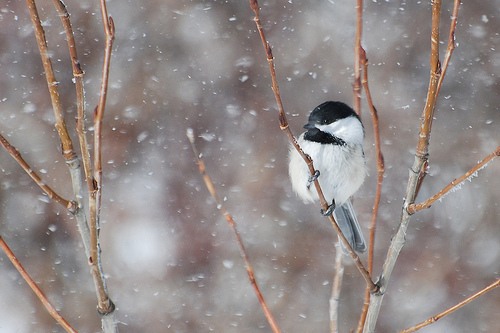Summer brings a wealth of avian activity descending towards Denali National Park. Over 200 species of migrants from all over the globe arrive on the subarctic ecosystem to take advantage of abundant food sources, including insects and seeds. As the summer wanes to autumn, they head south, back to many of their ancestral homes in the tropics, lower 48 states, and temperate wintering grounds. We do, however, have around 15 species of birds that stay with us year round in Denali. This includes two species of chickadee, the black-capped and boreal, who cheerily frequent our feeders and spruce trees throughout the year.
The black-capped chickadee is a common boreal resident. It’s winter biology has been well studied, and is worth a moment to contemplate their awe-inspiring day to day existence. Chickadees spend their entire lives within a home range of about a half-mile square, over which they cache away seeds beginning in late summer to prepare for the winter ahead. They store them in cracks of tree bark and other crevices scattered around their home ranges, not in one giant larder like many mammal species do. To remember the locations of their food sources, their brains expand in the autumn (!!!), and reduce again in the spring as the need to memorize locations tapers off.
Keeping warm is difficult for a creature that tops the scales at less than the weight of two pencils. Temperatures in interior Alaska frequently dip to around 40 below several times a winter. They use their chest muscles to shiver and generate heat, then keep that heat layered close to their bodies with nearly an inch thickness of feathers puffed up around them. They must maintain a body temperature of 110F during the day, and to do so eat close to 10% of their total body weight daily, then burn it off at night!
Chickadees roost together in cavities nightly, using each others collective body heat to stay warm, while continuing to burn their precious calories. And in the morning (which, in the dead of an Alaskan winter, will sometimes not start until after 10am) they disperse to feed again.
What an amazing winter world we are surrounded by here along the banks of the Nenana River at our winter office.
Denali Dispatch
Denali Dispatch is a journal of the goings on at Camp Denali.




